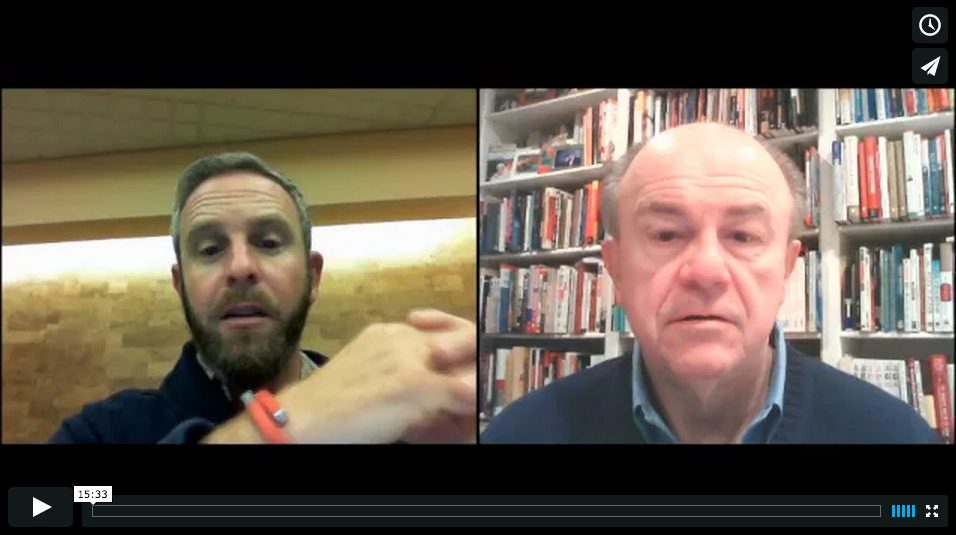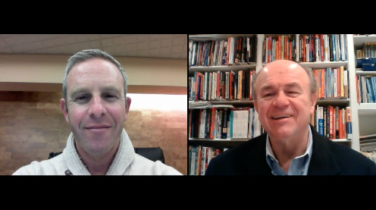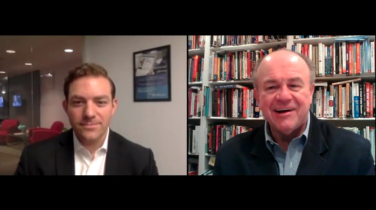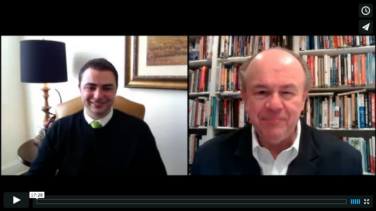David Zaritsky, President of PulseCX, reveals a new way pharma marketers can approach the customer experience. Rather than just offering sales details or relying on quick interactions with customers, companies can create a surround-sound wellness experience that actually integrates your brand into a customer’s story. By digging in with a customer experience audit—including both qualitative and quantitative data—marketers can find the gaps that will allow them to create an experience that is completely unique to their brand. It also allows them to bring the Ritz-Carlton experience to pharma by providing the customer with what they want when they ask for it—within regulatory bounds of course. Contact David at dzaritsky@pulsecx.com to learn more.
Transcript
Bud Bilanich: Hi, everybody. Bud Bilanich here with David Zaritsky of PulseCX. This is another PM360, Experts on Call. David and his company are experts on customer experience in pharma. So welcome, David, and let me just ask you a little bit about PulseCX, and when we talk about the customer experience, what do you mean by that?
David Zaritsky: Absolutely. Well, PulseCX is—it’s a marketing service company that’s been around for about 32 years and really had a wonderful foundation and beginning in direct marking and CRM. So right from the get-go, connecting with patients, payers and healthcare professionals along the way. We’ve morphed, as the industry has morphed, as you can imagine, and there are more and more companies within pharma who are trying to drive more than just a sales detail, more than just a quick interaction with the healthcare professional to the representative and even to the patient. They’re trying to create a surround sound wellness experience, whether it’s Merck or Amgen or several other companies that have really gone head first into these types of experiences.
What they’re trying to do is they’re trying to create impact points. That’s all this is. And the best way to describe this is if you think about the healthcare professional, the patient and the payer, they’re all characters in this story. There’s like a journey going on in pharma, if you will. And what the pharma marketer who’s savvy, who’s trying to drive an experience is, they’re trying to create connections between all three of those and try to find a way for the brand to be integrated into their storyline as opposed to forced, as opposed to push, which is kind the old tried and true way of marketing.
Bud Bilanich: That’s really interesting. So what, at PulseCX, how do you go about doing that?
David Zaritsky: Yeah, we start with asking questions. I mean, you know, we have something called a customer experience audit, and essentially what that is, is it’s walking into, you know, a group of marketers and starting to ask the very simple question, what’s the experience that your brand is creating today? And if your brand hasn’t launched, you could ask: What is the experience that your competitors are creating today? And then take that experience and plot it along the journey of the patient. So for example, a lot of patients go through pre-diagnosis, diagnosis, treatment, lifestyle adherence.
That’s kind of the four main quadrants of the experience, but they may have a disconnect. They may have a gap in the experience. Or their competitors might have a gap in the experience and then the marketer can say, “You know something? Instead of playing catch-up with our competitors and trying to be like them, let’s do something different. Let’s own a unique experience that is wholly ours.”
Bud Bilanich: Let me give you an example. Several years ago I had thyroid cancer, and so once I had thyroid cancer and I no longer have a thyroid so I no longer have any natural metabolism, and so I take a product. So I realize this probably doesn’t apply because it’s such an old product obviously, Synthroid, but how would you then—if you were asked to help reposition or create the customer experience for Synthroid, what might you advise a marketer to do?
David Zaritsky: Yeah. So the first step is speaking to you, to the patients or the people that are using Synthroid. Quantitative and qualitative data, so doing face-to-face focus groups and research and interview. And what’s nice about experiential marketing is in the old days when you wanted to do market research you kind of scratched your head and said, “You know, I feel like we need to do this.” With customer experience, you actually know you need to connect with the patients.
You need to get the quantitative, qualitative data. So I’d ask you, “What was your experience with Synthroid? What was the educational support they gave you, what was the emotional support that they gave you?” And then I would connect that with a healthcare professional. What was the emotional and functional support and experiences that they had in talking to you about Synthroid. You know, maybe you have a healthcare professional that is a bit of a Sherpa or an educator. Did Synthroid give that healthcare professional all the necessary experiences, you know, data points, brochures, etc., to have a good conversation with you to create a positive experience?
Bud Bilanich: Yeah. Well, you know, like particularly in my case, I was so relieved by the fact that once the actual surgery was finished, that I was cancer free, so I was pretty happy just to be given the product. So they didn’t have to, I think, focus that much with me, but thinking on it right now, I still have to remember to take it, you know, it’s an adherence issue I guess, every morning.
David Zaritsky: Sure.
Bud Bilanich: And I’m in that routine, but still it’s a—it would be much better if I could have like a once-a-day dosage or once-a-month dosage.
David Zaritsky: Well you—but you bring up a good point. So the experience has to pain the picture of what is the end goal, obviously being cancer free, being very happy, and sharing that story that you’re cancer free, but what is that—what’s that roadmap along the way to do that? And then how does the brand, how does the healthcare professional support that so you can get there and obtain that experience or goal?
Bud Bilanich: Yeah, so just what I’m hearing you say, I really like this, is that you’re kind of turning it upside down because basically the pharma company starts with this great product that we have for whatever, and now what we’re doing is we’re trying to say, okay, here are the people who need this. And you’re saying, okay, you might need this kind of a product patient or Bud in my case, and we’re going to figure out what makes—what would make a good experience for you so we can then help position—help marketers position the product better.
David Zaritsky: Exactly. You nailed it. And really it’s that movement from being brand centric to experience or customer centric which was a big movement three to four years ago, but I think it’s starting to really hit its stride now and focusing exactly how you talked about it.
Bud Bilanich: So that makes sense from talking about, say, the healthcare professionals, what about the payers? I mean how does a marketer then take your approach with payers? Because they’re getting increasingly difficult in terms of what they want to pay.
David Zaritsky: Absolutely. And the process is not very different. So it’s stepping back and talking to the payers about their attitude, for example, to a particular pharma company. And you know this all too well, some companies have done a better job of building the relationship with the payers than others. That’s just the reality of it.
So in looking back at that customer experience audit, can you go to the payer and say, “Is there a disconnect in the relationship between the brand or our particular company,” and how do we—how to really create some connective tissue between that relationship and experience. And I’ll give you an example. A lot of the payers are starting to raise their hand and saying, “We would love a brand experience where they offer pretty much a contract to cure. So we will pay you the full amount for this particular disease state and therapy, but you need to promise a cure rate. If you are that secure in that, then let’s put it back.”
So contracts-to-cure is another way to drive an experience. However, you’ve got to go back to the payer. The brand has to go back to the payer and say, “That’s fine. If we have a contract-to-cure, guess what you need to do? You need to focus on the adherence. You’re connected to the healthcare professional, you’re connected to the patient, you’ve got to drive that. It cannot just be the brand.” So it’s a little bit quid pro quo.
Bud Bilanich: Well the contract to cure is very interesting, but what happens if you have a chronic condition, say like I have, with, you know, which requires me to take Synthroid? Obviously, there’s no cure.
David Zaritsky: There is no cure. So instead, that last part of the journey, as opposed to just treatment and cure is lifestyle. So more and more companies are thinking about how do we focus on creating a lifestyle so if there’s remission or something that goes back, even if it’s something that’s acute, you know, there may be other comorbidities, it’s probably hard to pick up. But I’m wearing a Jawbone, which is like one of those Fitbit things that surround you with, you know, your movement and health.
These are becoming adopted by pharma companies because they’re saying, “David Zaritsky, we just saw you. Our brand just connected with you. But you know something? We know that you have a 27-life—you have health and wellness beyond that brand. We want to connect with you on a regular basis,” and they’re starting to actually fund and connect with these types of units.
Bud Bilanich: Well that’s very interesting. That’s very, very interesting. So now let’s talk about the big elephant in the room and that’s the regulators. And, you know, it’s tough to market when your claims have to be so specific and, you know, tied to what’s been approved. So how do you build the whole customer experience in considering the fact that there’s so many regulations that pharma marketers are held to?
David Zaritsky: Yeah. It’s—so it’s the translation. I’ll give you a perfect example. We worked a few years ago with BMS. And BMS wanted to stop their sales people from selling, which sounds counterintuitive, but they wanted to start creating an experience with the physicians, with Baraclude. And the physicians, you know, again, did the customer experience audit and realized they were looking for that Ritz-Carlton-like experience. So when you walk into a doctor’s office, it wasn’t let me show you this brochure, it was what keeps you up at night, doctor?
You know, what do you experience? What does your staff need? You know, from an administrative point of view, what’s difficult in connecting with your client? And the reps started to create that Ritz-Carlton-like experience. That being said, we actually went to the gentleman who wrote the book on Ritz-Carlton, Milton Pedraza, and we spoke to him, but we needed to be the translators between that gentleman, who obviously has no regulations at Ritz-Carlton you can do anything, all the way through to putting it through our customer experience filter and then back to BMS to make sure that reps wouldn’t get their fingers slapped by regulatory.
Bud Bilanich: Yeah. So it’s a long way from the days of pharmaceutical lunches.
David Zaritsky: Oh my gosh, yeah. The pizza and balloon and, you know, detail of a detail and washing your physician’s car. Yes, a long way.
Bud Bilanich: Well I think the idea of the Ritz-Carlton experience is absolutely fascinating, and again, if you could just talk a little bit more about the regulatory part of that, is how do you avoid the issues that can come up with a rep inadvertently overstepping his or her bounds?
David Zaritsky: Yeah, so the best thing to do, and almost every individual that we see out in the pharma space we bring up the Ritz-Carlton, and they do exactly like you. They’re like, “I’m sorry. How does that translate to my regulatory chaos that I have?” It really needs to start with creating a toolbox of experiences. And so instead of—at Ritz-Carlton, essentially what it is, is that you can do anything for someone staying at the Ritz-Carlton. There are no limits.
If they want a blue pen instead of a black pen, you can go get them a black pen. What this does it is gives the sales rep, for example, very finite, specific and improved experiences that they can deliver. But not just one or two and not just off the features and benefits of the brand, but let’s say six or seven experiences that the rep can say, “Ah. The doctor just said this word. It’s triggering a certain experience that I need to create. In my toolbox of things on my iPad, I know that he’s asking about the payer landscape. So me go to him and drive that experience,” and it makes it a little bit more configurable for the sales rep and for the experience.
Bud Bilanich: So these are—what you’re attempting to do is put together these experiences for the rep as they approach the doctor and they all—your—as much as anybody can be these days, you can pretty sure that the they are approved and they’re not going to get themselves in any kind of difficulties in terms of making claims that they can’t make.
David Zaritsky: That’s right. And all the tools that you give them are approved. And the most important thing is that it’s not just tools in a toolbox, but they’re tools that were created by the rep for the rep from that customer experience audit that I told you about earlier. It’s from the feedback of the patients and healthcare professionals of what they want, what kind of an experience they want. So the sales rep is drinking in, the marketer’s drinking in, and the healthcare professionals accept the experience.
Bud Bilanich: Well I think it’s really cool. If people are interested in hearing more about what you do and how you conduct these audits, I mean we’ve had like a, you know, very brief period here, how can they get in touch with you guys?
David Zaritsky: So there’s two basic ways to do it. You could email me at dzaritsky@pulsecx.com. I’m sure we’ll make that email available. Or they can call us at 215-704-9418.
Bud Bilanich: That’s great. And Zaritsky is pretty much just like it’s spelled—it sounds. Z-A-R-I-T-S-K-Y, correct?
David Zaritsky: That’s correct, yes.
Bud Bilanich: That’s really cool. Hey, let me ask you one last thing.
David Zaritsky: Sure.
Bud Bilanich: As we finish up here, if you were to offer one piece of advice to somebody who has, say is launching a product, and you’re talking about the customer experience, what would it be?
David Zaritsky: My advice would be don’t get it into your head that because you’re with a company that has not done it before that it can’t be done. There are companies for the last few years that are—they’re really breaching new experiences by breaking through that wall of, “Oh, that’s not like company X. We couldn’t possibly do that. The regulatory, you know, landscape is too difficult. This is too hard. It’s too chaotic. That’s not us.” Don’t accept that. Drive something new. You deserve it.
Bud Bilanich: That’s really great advice. That’s pretty good advice for just about the anything. Managing your own career or managing a business, just because you haven’t done it before doesn’t mean that you can’t–
David Zaritsky: Exactly.
Bud Bilanich: —and shouldn’t. Well that’s really great. So David, thank you so much. Really appreciate your time. You know, both of us struggling a little bit here with our voice, so I appreciate you taking the time to chat with me this morning. And again, folks, this has been an Expert on Call interview with David Zaritsky, President of PulseCX, all about the customer experience in pharma. So thank you, David, I really appreciate your time.
David Zaritsky: Thank you, Bud.





